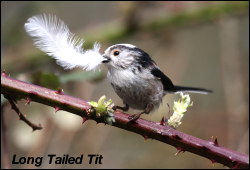April 29, 2012 at 12:21 pm
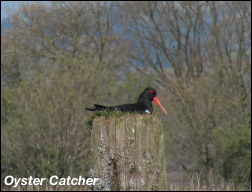
After last weeks sunshine on Islay it was back to normal at home with more rain and a cold North East wind. I came across a pair of Oyster Catchers that had finally laid their eggs in a shallow depression on the top of a post. It was no chance finding as ten years ago, with the farmers permission, I hollowed out the top of the post anticipating just such an event. Unfortunately it took ten years to happen!
On one very wet morning I came across a brilliant male Merlin on a rock by the road as it eyed up a Meadow Pipit. It was only a brief view but what a subject, they really are the star of the Pennine birds. A single Ring Ouzel was singing at a breeding site nearby but its female could not be located so hopefully she was sat tight on eggs in the poor conditions.
Another day out produced two pairs of Little Owls on dry stone walls. Both were at the same stage with the male courting the female by presenting her with prey and then preening her. She returns the compliment by preening him in what is called allopreening, an event that is seldom filmed. Sadly both pairs were too far away for me to capture on camera but just to witness it makes it a special occasion.
Despite the poor weather the breeding season marches on and I now have had two pairs of Dippers that have fledged young. Meanwhile Pied Flycatchers and Redstarts are flooding into the woodlands and let’s hope we see more Wood Warblers this year.
April 22, 2012 at 7:44 pm
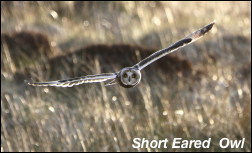
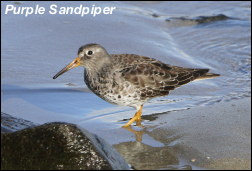
After last year’s poor weather on Islay we have just had a week on the island that produced well in excess of sixty hours of sunshine. It was like the Islay of old with spectacular sunrises and sunsets and the only rain falling during the night when we were asleep.
April on Islay is a fabulous time to visit because of the mix of both Winter and Spring migrants. Nine thousand Barnacle Geese left for Greenland the day after we arrived, with Swallows and Wheatears in many parts of the island having just flown up from Africa. On the eighteenth we found the first migrant Corncrake which was followed the following day by the first Cuckoo. In contrast Brent Geese and Great Northern Divers were still present before their long journeys North as were Purple Sandpipers and Sanderlings.
Nine species of Raptor were encountered, with the male Short Eared Owl, above, performing very well as he hunted most evenings. We had some good encounters with both Golden Eagle and Sea Eagle.
A female Adder was watched in the sunshine at Ardnave. However a trip to Jura, in perfect conditions, failed to find any Otters. Our success rate in locating Otters in now about fifty percent and I have great respect for this creature that is never predictable.
April 15, 2012 at 8:11 pm
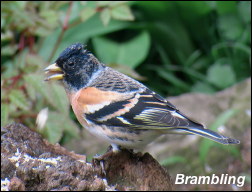
This week’s photo is of the male Brambling that fed for one day only last week. The snow fall stopped him migrating back to Lapland but it couldn’t stop his plumage coming to its Summer best when he will have an all black head. The only birds missing from the garden this Winter have been Redwing and Fieldfare. At the moment we still have feeding at least a dozen Reed Buntings, six Bullfinches and for the first time ever three Redpolls.
A search in the hills failed to produced Woodcock and Merlin but I did see a Snow Bunting and a Twite which are elusive birds these days. Even walking the dogs along the canal yielded a feeding male Goosander and a Green Woodpecker yaffling.
April 1, 2012 at 12:32 pm
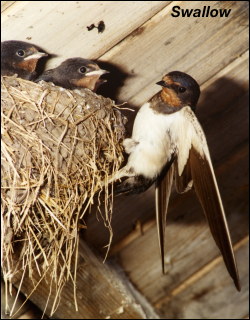
On the 22nd March whilst driving down the M6 at Preston a Swallow flew across the road in front of my car. It was the earliest Swallow I have ever recorded by at least a week and heralded the arrival of a fantastic week of Summer weather with temperatures of over 20°C each day. There has been an explosion of butterflies with 5 Peacock, 4 Small Tortoiseshell and one Comma, all seen on Hopwood in one day.
During the week I have filmed a Kingfisher digging its tunnel and a pair of Long Tailed Tits lining their nest with feathers. (Photo next week) Normally they seek out white feathers for their nest and will readily take any that I put out for them. This time they picked them up but instead of taking them back to the nest they disposed of them away from the nest. I had obviously found the only pair of Long Tailed Tits that did not like white feathers!
Whilst the warm weather has produced very early foliage it was in fact too hot for basking Adders and my first visit of the season produced no sightings. More disappointing though has been the disappearance of two of my regular pairs of Long Eared Owls – does this mean there is a shortage of voles this year.
March 25, 2012 at 6:48 pm
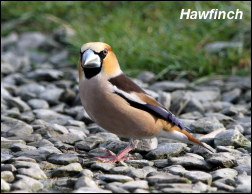
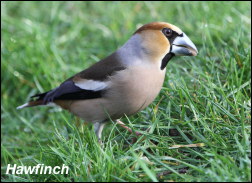
This Winter has not been the best for numbers of birds so I couldn’t resist the temptation to include two of my favourite photos I took of a Hawfinch. I waited a lifetime to capture on film this elusive bird and I have some amazing clips of the Hawfinch breaking open Hornbeam fruit with its incredible bill. It will certainly be one of the highlights of the next DVD on Pennine Wildlife.
The recent high temperatures have brought out four Small Tortoiseshell butterflies on the 23rd and four Peacock butterflies on the 24th. Ironically it was in the Ribble valley today, Sunday, that I saw a flock of fifty Fieldfares – the largest I have encountered this Winter! The warm sunshine also gave me good views of a Goldcrest bathing in a pinewood stream.
In the garden the Willow Tit is still a regular visitor, mainly in the late afternoon. The six Bullfinches are now in pairs with at least six individual Reed Buntings feeding.
When you spend a lifetime observing birds at the nest it is always sad when a nest you have been watching is predated, especially when it is an elusive species like a Crossbill. I have spent a fortnight filming both birds going to and from the nest that was thirty foot off the ground on a branch overhanging a road. One day all was well and the young were near to fledging but at 9am the following morning a crow flew from near the nest and part of the nest was on the road below, with no sign of the young. There is nothing we can do about natural predation but you have to feel sorry for the adult Crossbills who spent the last two months totally devoted to rearing their young, all to no avail.






